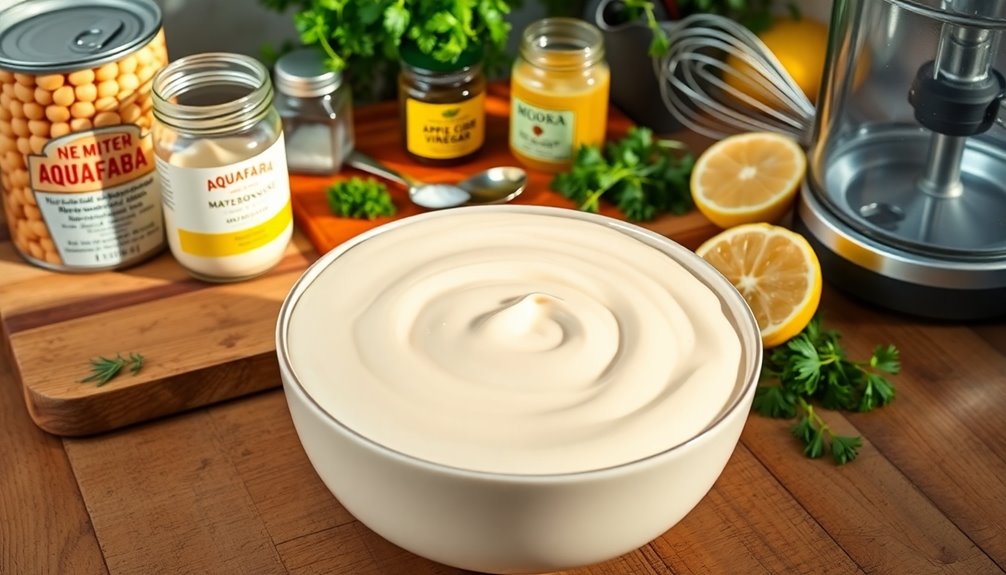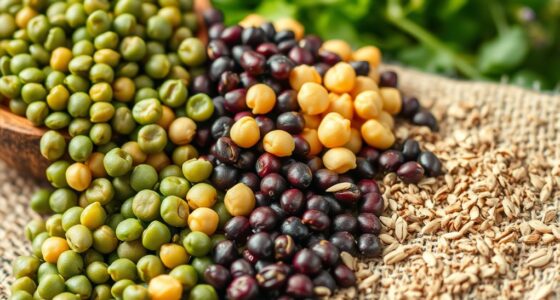Aquafaba mayonnaise is a delicious vegan alternative to traditional mayo. Made from the liquid of canned chickpeas, it mimics the creamy texture of eggs while being customizable. Combine aquafaba with oil, vinegar, mustard, and seasonings to create a smooth condiment for your salads, sandwiches, or dips. It's easy to make, lasts up to two weeks in the fridge, and reduces food waste. Keep exploring to discover its benefits and recipe variations!
History
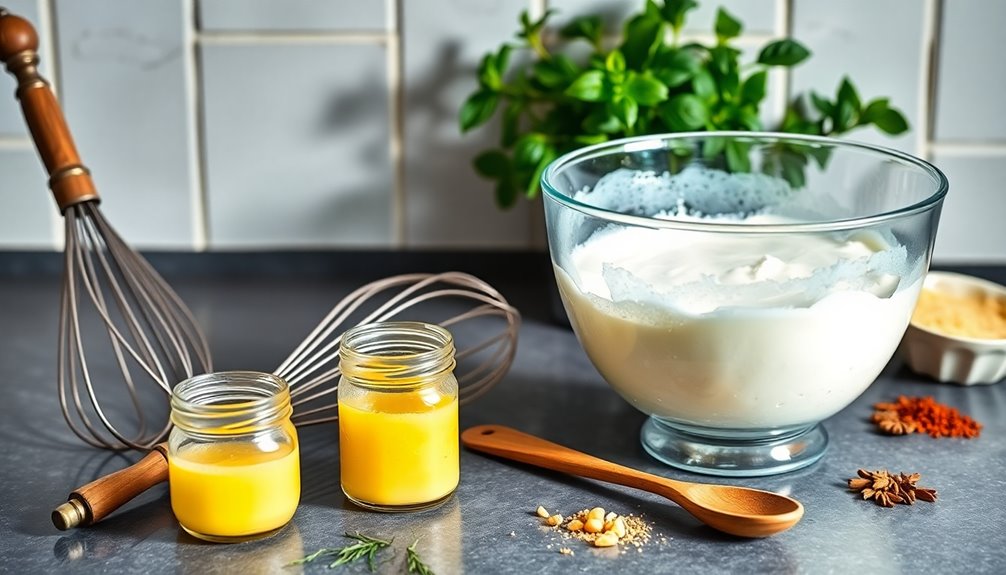
Although aquafaba may seem like a recent culinary trend, its journey began in 2015 when French chef Joël Roessel revealed its incredible ability to replace eggs in recipes.
Derived from the Latin words for water and bean, aquafaba is the liquid leftover from cooking legumes, particularly chickpeas. This innovative ingredient quickly gained traction in vegan recipes, thanks to its ability to mimic the texture and functionality of egg whites.
Aquafaba, the liquid from cooked chickpeas, mimics egg whites, revolutionizing vegan recipes with its versatile texture and functionality.
As you explore homemade aquafaba, you'll find it perfect for creating creamy alternatives, like mayonnaise. Its popularity not only showcases its versatility but also promotes sustainability by reducing food waste from canned chickpeas.
Aquafaba has truly transformed vegan cooking, inspiring countless recipes and culinary enthusiasts.
Recipe
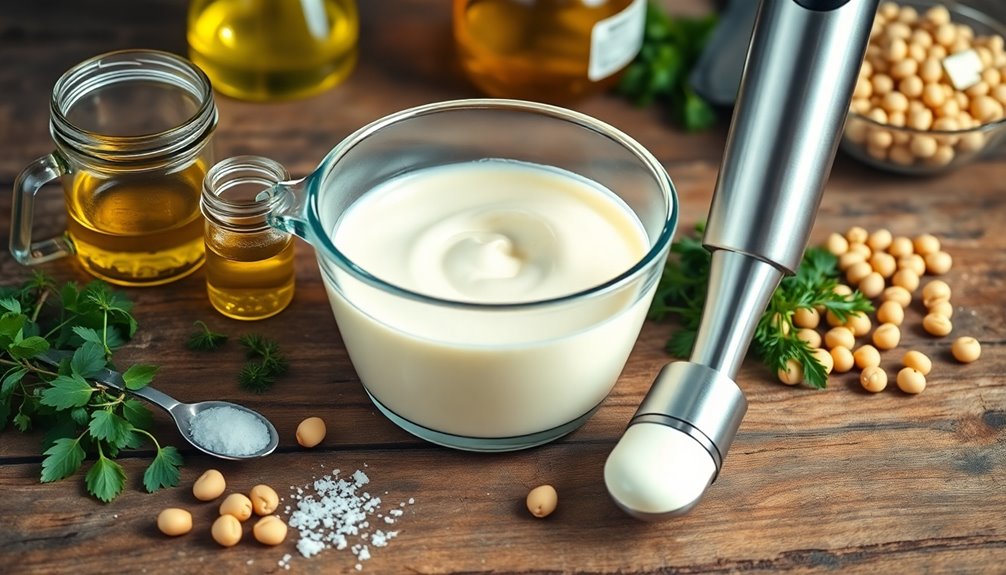
Aquafaba mayonnaise is a delightful and creamy vegan alternative to traditional mayonnaise, perfect for those looking to eliminate eggs from their diet. Made from the liquid of canned chickpeas, aquafaba acts as an excellent emulsifier, allowing for the creation of a smooth and rich condiment that can elevate a variety of dishes. With just a few simple ingredients, you can whip up this versatile mayonnaise in no time, making it an ideal addition to salads, sandwiches, and dips.
The beauty of aquafaba mayonnaise lies in its simplicity and adaptability. You can customize the flavor by adjusting the amount of vinegar, mustard, or even adding herbs and spices to suit your taste preferences. This recipe requires minimal equipment—a food processor or an immersion blender—and can be prepared in just a few minutes.
Once made, allow it to chill in the refrigerator to enhance its flavor and texture, making it ready to enjoy whenever you need a creamy dressing or spread.
Ingredients:
- 1/2 cup aquafaba (liquid from canned chickpeas)
- 1 cup neutral oil (such as sunflower or canola)
- 1 tablespoon vinegar (white or apple cider)
- 1 teaspoon mustard (Dijon or yellow)
- 1/2 teaspoon salt
- Optional: sweeteners, herbs, or spices for flavor
To make aquafaba mayonnaise, start by placing the aquafaba, vinegar, mustard, and salt in a food processor or a tall container if using an immersion blender. Blend the mixture until it becomes frothy, then slowly drizzle in the neutral oil while continuing to blend.
This gradual incorporation is key to achieving a creamy consistency. Once all the oil is added and the mayo is thickened to your liking, taste and adjust seasoning if needed. Transfer the mayonnaise to an airtight container and refrigerate for a few hours to allow it to thicken further and enhance the flavor.
When making aquafaba mayonnaise, it's important to keep the oil temperature in mind; using room temperature oil can help in achieving the right emulsification. If you find the mayo too thick, you can thin it out with a little bit of water or extra aquafaba.
Feel free to experiment with different types of vinegar or add in garlic powder, dill, or even a bit of lemon juice for added zest. Homemade aquafaba mayonnaise can last up to two weeks in the refrigerator, making it a convenient and delicious staple to have on hand.
Cooking Steps
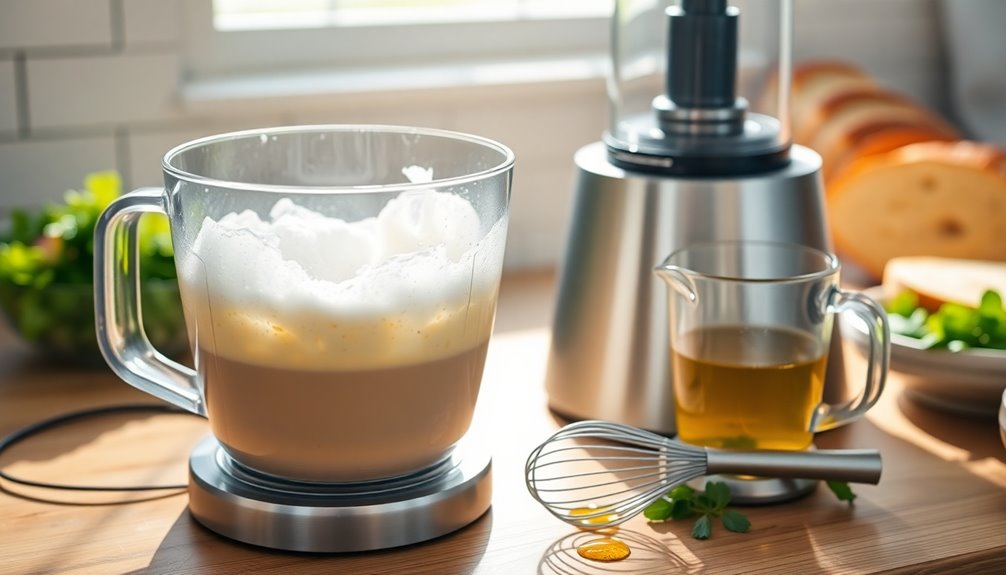
To start making your aquafaba mayonnaise, you'll need to measure the aquafaba accurately for the perfect texture.
Gradually add lemon juice and whisk in the oil slowly to ensure proper emulsification.
Don't forget to incorporate mustard for flavor and season with salt and pepper to taste!
Step 1. Measure Aquafaba Accurately

When you're ready to measure aquafaba, grab a liquid measuring cup for accuracy.
Pour the liquid from canned chickpeas until you reach about 3 tablespoons, which is the typical amount for standard mayonnaise recipes.
Keep in mind that aquafaba can vary in thickness and protein content based on the brand, so it's wise to test the consistency first.
If you're using homemade aquafaba, cook the chickpeas until the liquid thickens, enhancing emulsification in your mayonnaise.
Avoid aquafaba that's overly salty or contains additives; opt for salt-free canned chickpeas when possible.
Accurate measurement is crucial; too much or too little can compromise the final texture and stability.
Consider using a kitchen scale for precise weight if that's your preference.
Step 2. Add Lemon Juice Gradually
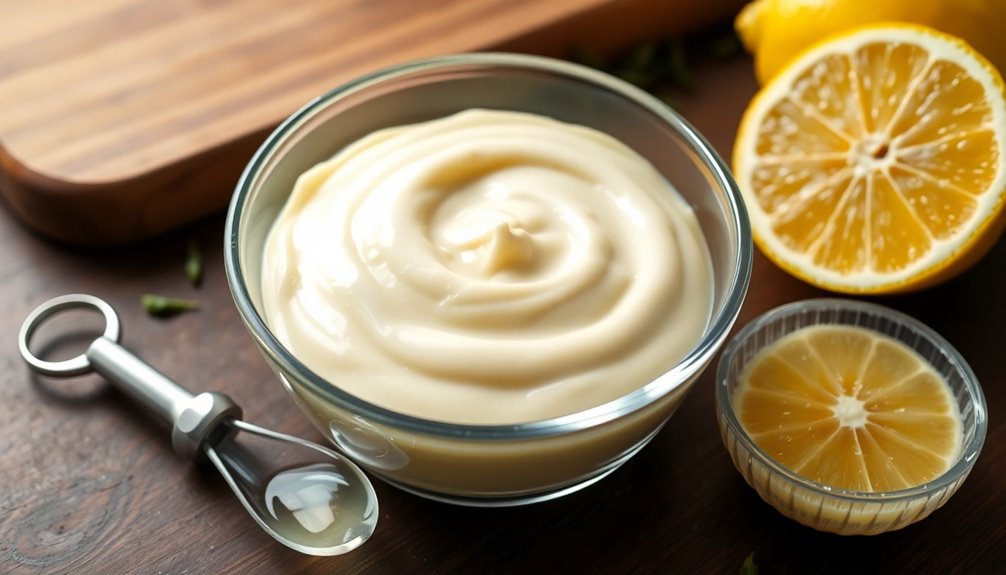
As you begin making your aquafaba mayonnaise, adding lemon juice gradually is essential for achieving that perfect creamy texture.
Start by combining aquafaba, mustard, and salt in a container. Blend these ingredients well, then slowly add lemon juice while blending at a high speed.
It's crucial to add lemon juice in small increments; doing so ensures proper emulsification and prevents curdling. If you rush this step or add too much lemon juice at once, you risk ending up with a runny mayonnaise consistency.
Begin with a tablespoon of lemon juice and adjust to taste for that desired tanginess. This careful approach guarantees a deliciously creamy result every time!
Step 3. Whisk in Oil Slowly

After you've incorporated the lemon juice, it's time to whisk in the oil slowly.
Begin by blending the aquafaba and other base ingredients for about a minute until frothy. Then, pour the oil in a thin, steady stream over the next 3-4 minutes. This gradual addition is crucial for proper emulsification, which helps prevent your mayonnaise from separating.
Keep your immersion blender close to the surface to aerate and thicken the mixture effectively. Adjust the oil amount based on your desired consistency; adding too much too quickly can lead to a runny mayonnaise.
With this technique, you'll achieve a stable, creamy texture that's perfect for any dish. Enjoy your homemade aquafaba mayonnaise!
Step 4. Incorporate Mustard for Flavor
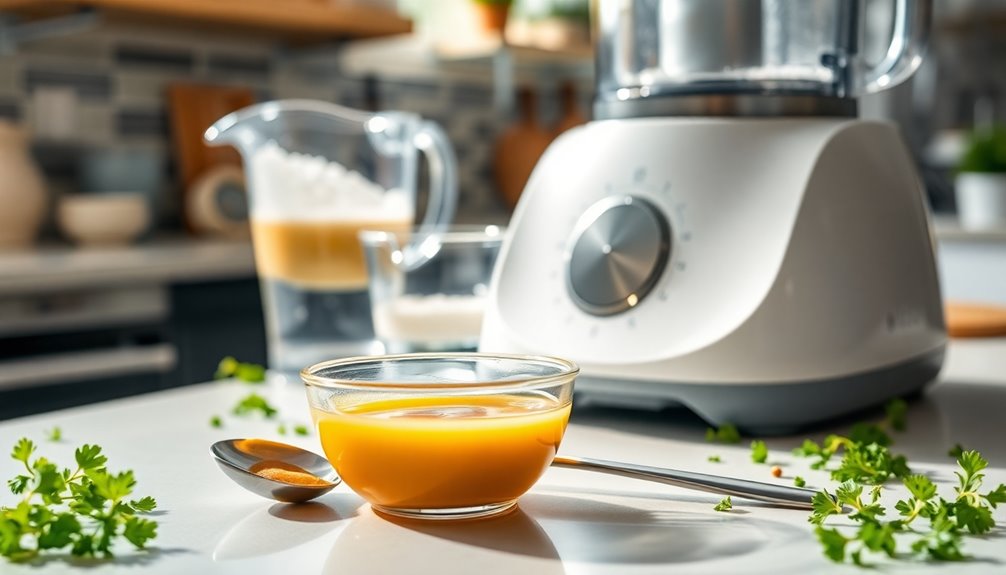
To elevate the flavor of your aquafaba mayonnaise, incorporate mustard early in the process. Start with about 1 teaspoon of mustard powder, adjusting it to your taste for a stronger flavor.
Mustard acts as an emulsifier in your aquafaba mayo, helping to stabilize the mixture and achieve that smooth, creamy texture you want. Blend the mustard with the aquafaba and vinegar before gradually adding your oil; this ensures optimal emulsification and flavor distribution.
For a tangy twist, consider using Dijon mustard instead of mustard powder. Its unique flavor adds depth and a delightful kick to your mayo.
Enjoy experimenting with different mustard varieties to find your perfect blend!
Step 5. Season With Salt and Pepper

Once you've blended your aquafaba mayo to a creamy consistency, it's time to season it with salt and pepper for that perfect flavor boost.
Start by adding about 1/2 teaspoon of salt, adjusting as needed to match your taste. Gradually blend in the salt to avoid overpowering the mayo.
Next, sprinkle in freshly ground black pepper for a subtle kick and aromatic depth. Remember to taste test during this process; it's key to achieving your ideal flavor profile.
If you crave a bit of tanginess, a splash of lemon juice can work wonders, enhancing the overall taste.
With these simple adjustments, you'll savor a personalized aquafaba mayo that's bursting with flavor!
Final Thoughts
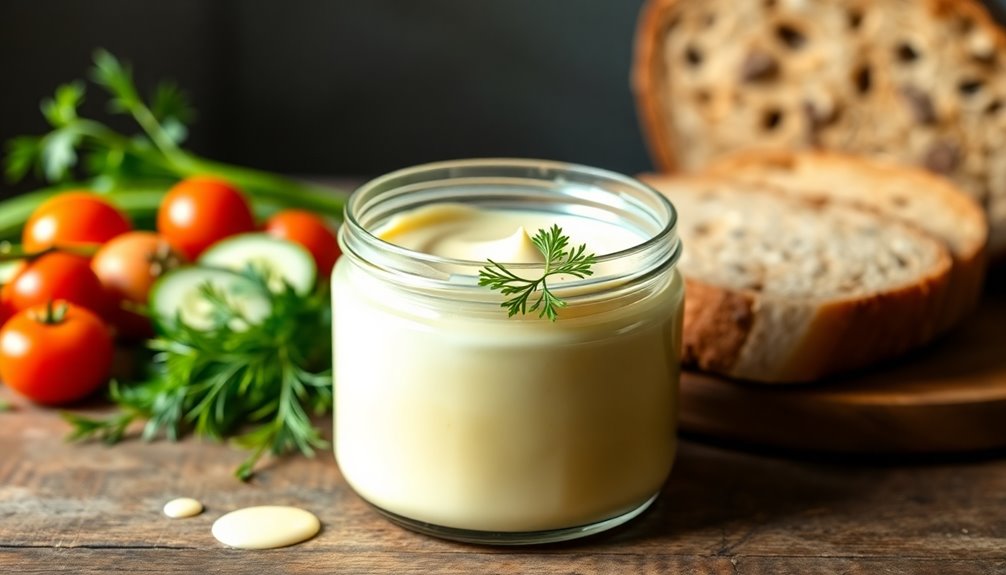
While some may hesitate to try aquafaba mayonnaise, its creamy texture and versatility make it an excellent choice for anyone looking to enjoy a plant-based alternative to traditional mayo.
This vegan homemade mayo not only offers a delightful flavor but also allows you to customize it with your favorite spices and acids. By blending aquafaba with ingredients like vinegar and oil, you can create a stable emulsion that suits your taste.
Plus, it's super easy to make! Once prepared, you can store it in the fridge in an airtight container for up to two weeks.
Whether you're spreading it on sandwiches or using it as a dip, aquafaba mayo is sure to elevate your dishes while keeping them plant-based.
Frequently Asked Questions
Can I Use Aquafaba to Make Mayonnaise?
Yes, you can use aquafaba to make mayonnaise! It's a fantastic egg replacer that helps achieve a creamy texture without using eggs.
Just combine aquafaba with oil, vinegar, mustard, and salt. As you blend, slowly add the oil to ensure proper emulsification. A typical ratio is about 3 tablespoons of aquafaba per cup of oil.
Feel free to customize it with herbs or additional flavors to suit your taste!
How Long Does Aquafaba Mayo Last?
If you're wondering how long homemade mayo lasts, it typically stays fresh for about a week when stored in an airtight container in the fridge.
You might extend its shelf life to two weeks if you keep it sealed and in a cool spot.
Just make sure to check for any changes in smell or texture before using it.
Labeling the preparation date helps you keep track of its freshness effectively.
Why Is My Aquafaba Mayo Not Thickening?
Did you know that about 30% of mayonnaise failures stem from emulsification issues?
If your mayo's not thickening, it could be due to adding oil too quickly, which disrupts the process.
Also, check the quality of your aquafaba; homemade versions can vary greatly.
Insufficient chilling time or incorrect ingredient ratios might be the culprit too.
Lastly, removing chickpea skins can make your mayo smoother and help achieve that perfect texture.
Why Not to Use Aquafaba?
You might want to avoid using aquafaba because it can lead to inconsistency in your dishes. The quality varies between brands, which affects texture and flavor.
If you're sensitive to legumes, it could cause digestive issues. Also, aquafaba may not provide the same stability as egg-based options, risking emulsification problems.
Lastly, its unique flavor mightn't appeal to everyone, making it a less versatile choice in your cooking.
